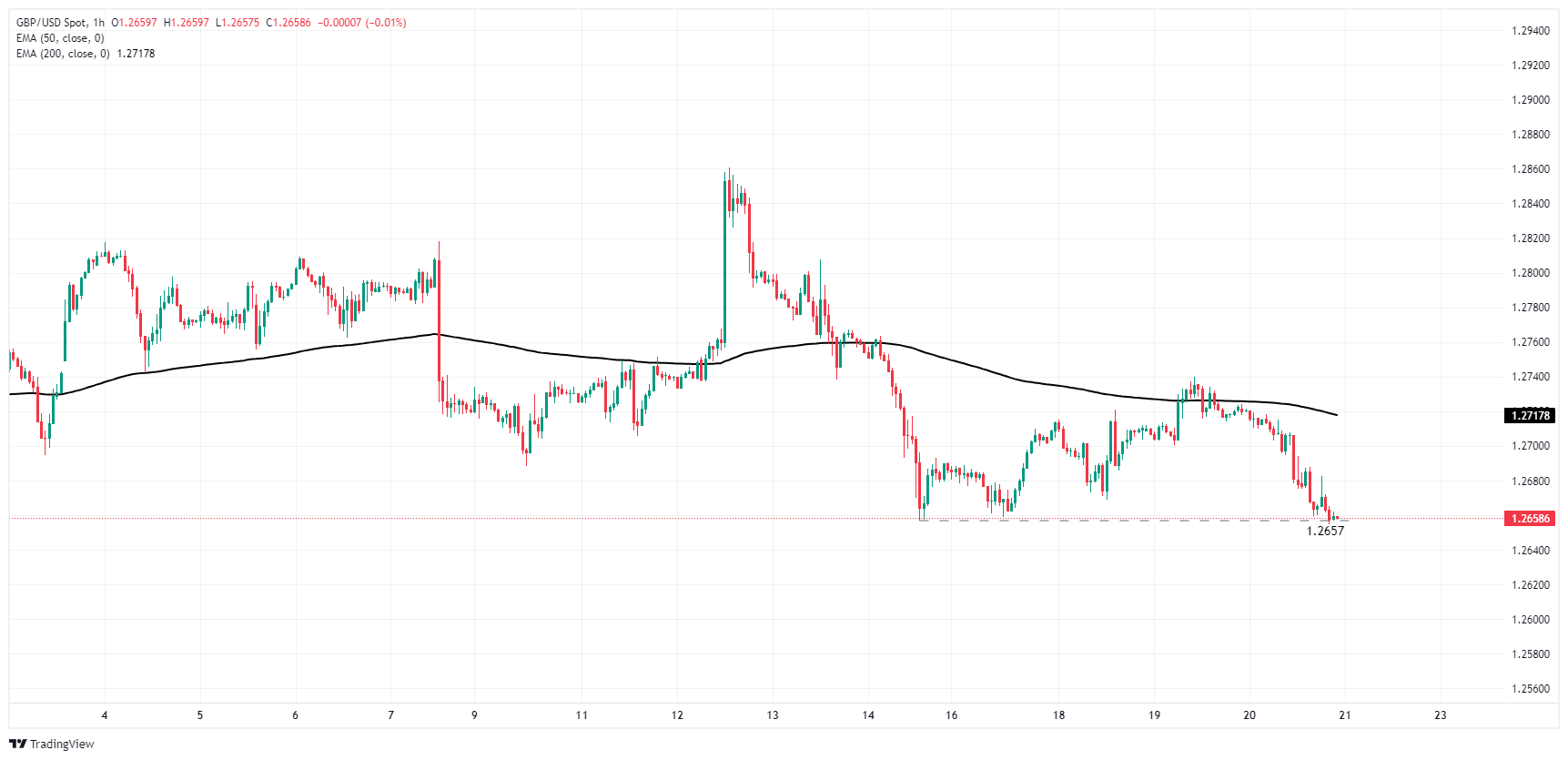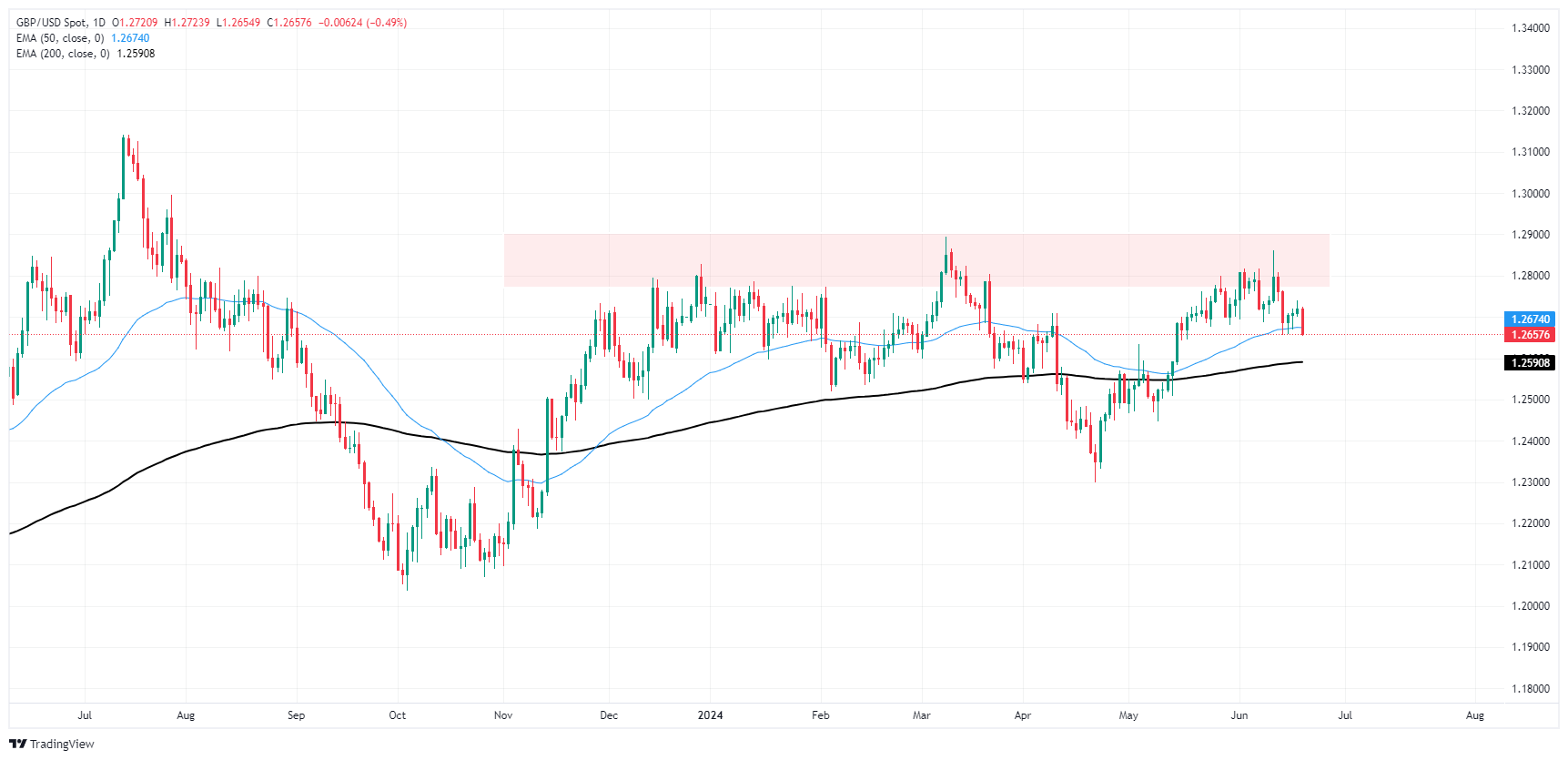GBP/USD falls into familiar lows as Friday looms with key UK data print
- GBP/USD eases back to 1.2650 as Sterling stumbles.
- UK Retail Sales, PMIs to close off the trading week with a bang.
- US PMI figures to add onto week’s data prints, expecting to soften.
GBP/USD is poised for a bumper Friday session. Key UK data is due during the European market session, and US Purchasing Managers Index (PMI) activity surveys set to wrap up the trading week. The Bank of England (BoE) held rates at 5.25% this week, with a stubbornly tepid stance on rate cuts that deflated broad-market rate cut expectations.
Forex Today: All the looks will be on PMI reports
The BoE was widely expected to keep interest rates unchanged in June. However, there was a focus on recent services inflation and a vague aim to keep inflation "sustainably" lower, which has left the value of the Sterling uncertain. Additionally, the BoE expressed a willingness to maintain restrictive policies for as long as necessary and emphasized that although the UK labor market is looser than before, it still remains historically tight.
Read more: BoE maintains policy rate at 5.25% as forecast
A miss in US economic figures softened investor risk appetite on Thursday, headlined by a worse-than-expected print in US Initial Jobless Claims coming in higher than expected for the week ended June 14. Week-on-week unemployment claimants are still lower, printing at 238K versus the previous 243K (revised from 242K), but still came in above the four-week trending average of 242.75K, which itself also rose from the previous 227.25K.
After the BoE voted seven-to-two to keep interest rates on hold at 5.25%, GBP traders will now focus on Friday's upcoming economic data. The scheduled releases include UK Retail Sales and updated S&P Global PMI figures for both the UK and the US. UK retail sales are expected to rebound to 1.5% MoM in May, compared to the previous decline of -2.3%. Additionally, UK PMIs are forecasted to show slight improvements. The Manufacturing PMI is expected to increase to 51.3 from 51.2, and the Services component is anticipated to rise to 53.0 from 52.9.
US Manufacturing and Services PMIs are both forecast to tick lower, with Manufacturing expected to slip to 51.0 from 51.3 and Services sliding to 53.7 from 54.8.
GBP/USD technical outlook
The value of the Pound Sterling dropped below the 1.2700 mark against the US Dollar on Thursday, showing a decline and moving lower towards recent lows at 1.2657. Technical indicators suggest a potential continuation of this bearish trend as the price failed to stay above the 200-hour Exponential Moving Average (EMA) at 1.2721. Further decreases in value are likely if there is no significant upward movement to reverse this trend.
The daily candlestick chart confirms a bearish rejection from a supply zone above the 1.2800 mark, indicating a potential return to the 200-day EMA, which is currently around 1.2580. The technical support provided by the 50-day EMA at 1.2674 is getting weaker, and if bearish pressure continues, GBP/USD could drop back to the 2024 lows around the 1.2300 level.
GBP/USD hourly chart
GBP/USD daily chart
Pound Sterling FAQs
The Pound Sterling (GBP) is the oldest currency in the world (886 AD) and the official currency of the United Kingdom. It is the fourth most traded unit for foreign exchange (FX) in the world, accounting for 12% of all transactions, averaging $630 billion a day, according to 2022 data. Its key trading pairs are GBP/USD, aka ‘Cable’, which accounts for 11% of FX, GBP/JPY, or the ‘Dragon’ as it is known by traders (3%), and EUR/GBP (2%). The Pound Sterling is issued by the Bank of England (BoE).
The single most important factor influencing the value of the Pound Sterling is monetary policy decided by the Bank of England. The BoE bases its decisions on whether it has achieved its primary goal of “price stability” – a steady inflation rate of around 2%. Its primary tool for achieving this is the adjustment of interest rates. When inflation is too high, the BoE will try to rein it in by raising interest rates, making it more expensive for people and businesses to access credit. This is generally positive for GBP, as higher interest rates make the UK a more attractive place for global investors to park their money. When inflation falls too low it is a sign economic growth is slowing. In this scenario, the BoE will consider lowering interest rates to cheapen credit so businesses will borrow more to invest in growth-generating projects.
Data releases gauge the health of the economy and can impact the value of the Pound Sterling. Indicators such as GDP, Manufacturing and Services PMIs, and employment can all influence the direction of the GBP. A strong economy is good for Sterling. Not only does it attract more foreign investment but it may encourage the BoE to put up interest rates, which will directly strengthen GBP. Otherwise, if economic data is weak, the Pound Sterling is likely to fall.
Another significant data release for the Pound Sterling is the Trade Balance. This indicator measures the difference between what a country earns from its exports and what it spends on imports over a given period. If a country produces highly sought-after exports, its currency will benefit purely from the extra demand created from foreign buyers seeking to purchase these goods. Therefore, a positive net Trade Balance strengthens a currency and vice versa for a negative balance.